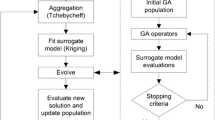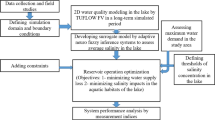Abstract
Reconciling simultaneous water quantity and quality aspects in drawing optimal reservoir operational strategy involves extensive computational burdens. Surrogate based optimization techniques (SBOTs) are common approaches to overcome computational bottlenecks of numerical hydrodynamic simulation models coupling evolutionary algorithm in simulation-optimization approaches. In this study, the reservoir high resolution CE-QUAL-W2 model is replaced by the lower resolution CE-QUAL-W2 and/or static ANN to speed up the optimization process. These surrogate models could consider the complex relationships to emulate the main dynamics of HR CE-QUAL-W2 model due to various reservoir operational strategies. The performance of various SBOTs, based on adaptive and sequential surrogate models coupled with particle swarm optimization algorithm, are evaluated in deriving optimal reservoir operational strategies. Then adaptive surrogate model, as the more efficient and accurate one, is applied to derive long term optimal reservoir operational strategy in the selective withdrawal scheme. The results show application of the proposed approach could enhance downstream water temperature, water demand satisfactions, and hydropower peak energy generation compared with the standard operation policy (SOP) in Karkheh reservoir during 15-year-time horizon.







Similar content being viewed by others
References
Abudu S, King JP, Sheng Z (2011) Comparison of the performance of statistical models in forecasting monthly total dissolved solids in the Rio Grande. J Am Water Resour Assoc 48(10):1–23
Afshar A, Saadatpour M (2009) Reservoir eutrophication modelling, sensitivity analysis, and assessment; application to Karkheh reservoir, Iran. Environ Eng Sci 26(7):1227–1238
Cahskan A, Elci S (2009) Effects of selective withdrawal on hydrodynamics of a stratified reservoir. Water Resour Manag 23:1257–1273
Castelletti A, Yajima H, Giuliani M, Soncini-Sessa R, Weber E (2012) Planning the optimal operation of a multi-outlet water reservoir with water quality and quantity targets. J Water Resour Plan Manag 140(4):496–510
Cole TM, Wells SA (2008) User's guide for CE-QUAL-W2: a two-dimensional, laterally averaged, hydrodynamic and water quality model, version 3.5. Washington, DC: U.S. Army Corps of Eng., draft file report, 20314-1000.
Edinger JE (2002) Waterbody hydrodynamic and water quality modeling: an introductory workbook and CD-ROM on three dimensional water body modeling. ASCE PRESS, Reston. Chapter 11 on surface heat exchange relationships.
Ferreira AR, Teegavarapu RSV (2012) Optimal and adaptive operation of a hydropower system with unit commitment and water quality constraints. Water Resour Manag 26:707–732
Hong YS, Bhamidimarri R (2011) Dynamic neuro-fuzzy local modeling system with a nonlinear feature extraction for the online adaptive warning system of river temperature affected by waste cooling water discharge. Stoch Env Res Risk A 27:1–14.
Hu M, Huang GH, Sun W, Li Y, Ding X, An C, Zhang X, Li T (2014) Multi-objective ecological reservoir operation based on water quality response models and improved genetic algorithm: a case study in three gorges reservoir, China. Eng Appl Artif Intell 36:332–346
Johnson VM, Rogers LL (2002) Accuracy of neural network approximation in simulation-optimization. J Water Resour Plan Manag 126(2):48–56
Karamouz M, Ahmadi A, Moridi A (2009) Probabilistic reservoir operation using Bayesian stochastic model and support vector machine. Adv Water Resour 32:1588–1600
Liu Y, Minsker BS (2002) Efficient multi-scale methods for optimal in situ bioremediation design. J Water Resour Plan Manag 128(3):227–236
Mahab Ghodss Consulting Engineering (MGCE) (2011a) Integrated soil and water study in Karkheh River Basin (In Persian)
Mahab Ghodss Consulting Engineering (MGCE) (2011b) Environmental impact assessment study on Tange-mashoure dam and hydro-power plant (In Persian)
Makvandi M, Nabavi SM, Savari A, Hasounizadeh H (2006) Survey on water quality and water pollution sources of HAWR AL-AZIM wetland and water pollution management. 3rd Iranian congress on environment crises and their rehabilitation methodology, Ahwaz, Iran (In Persian)
Paredes J, Lund JR (2006) Refill and drawdown rules for parallel reservoirs: quantity and quality. Water Resour Manag 20:359–376
Razavi S, Tolson BA, Burn DH (2012) Review of surrogate modeling in water resources. Water Resour Res 48(7):1–32
Rheinheimer DE, Null SE, Lund JR (2014) Optimizing selective withdrawal from reservoir to manage downstream temperature with climate warming. J Water Resour Plan Manag. doi:10.1061/(ASCE)WR.1943-5452.0000447
Saadatpour M (2012) Deriving optimum reservoir operation strategy considering quality and quantity objectives. Dissertation, Iran University of Science and Technology
Saadatpour M, Afshar A (2013) MultiObjective simulation-optimization approach in pollution spill response management model in reservoirs. Water Resour Manag 27:1851–1865
Shirangi E, Kerachian R, Bajestan MS (2008) A simplified model for reservoir operation considering the water quality issues: application of the young conflict resolution theory. Environ Monit Assess 146:77–89
Simpson TW, Peplinski JD, Koch PN, Allen JK (2011) Metamodels for computer-based engineering design: survey and recommendations. Eng Comput 17:129–150
Soleimani S, Bozorghaddad O, Saadatpour M, Loáiciga H (2016) Optimal selective withdrawal rules using a coupled data mining model and genetic algorithm. J Water Resour Plan Manag. http://ascelibrary.org/doi/abs/10.1061/(ASCE)WR.1943-5452.0000447
Teegavarapu RSV, Ferreira AR, Simonovic SP (2013) Fuzzy multi-objective models for optimal operation of a hydropower system. Water Resour Res 49(6):3180–3193
Tourassi GD, Frederick ED, Markey MK, Floyd CE Jr (2001) Application of the mutual information criterion for feature selection in computer-aided diagnosis. Am Assoc Phys Med 28(12):2394–2402
Yin XA, Yang XF (2011) Development of a coupled reservoir operation and water diversion model: balancing human and environmental flow requirements. Ecol Model 222(2):224–231
Author information
Authors and Affiliations
Corresponding author
Rights and permissions
About this article
Cite this article
Saadatpour, M., Afshar, A. & Edinger, J.E. Meta-Model Assisted 2D Hydrodynamic and Thermal Simulation Model (CE-QUAL-W2) in Deriving Optimal Reservoir Operational Strategy in Selective Withdrawal Scheme. Water Resour Manage 31, 2729–2744 (2017). https://doi.org/10.1007/s11269-017-1658-x
Received:
Accepted:
Published:
Issue Date:
DOI: https://doi.org/10.1007/s11269-017-1658-x




